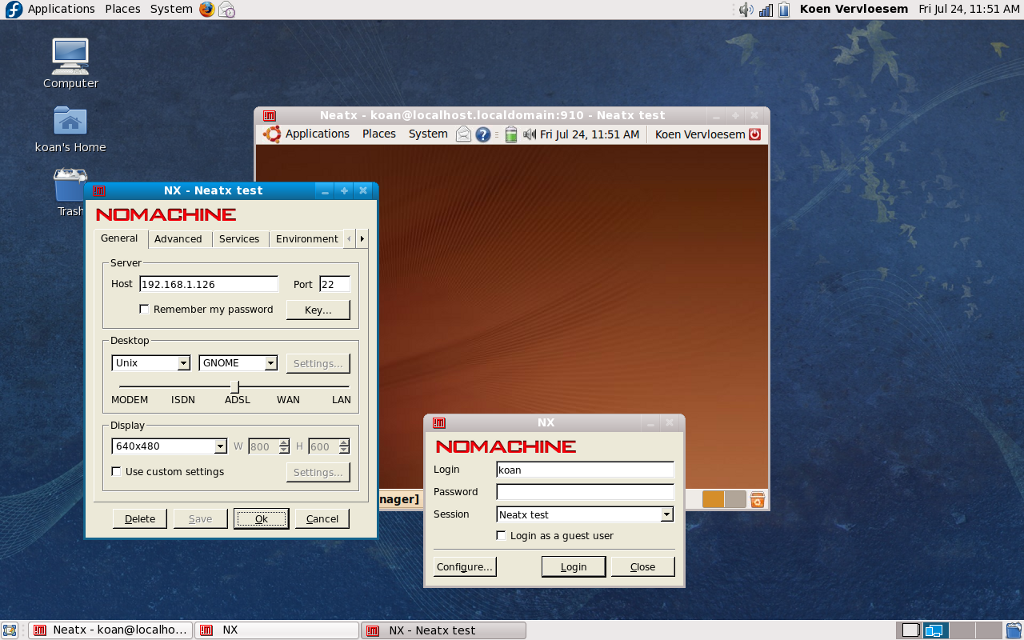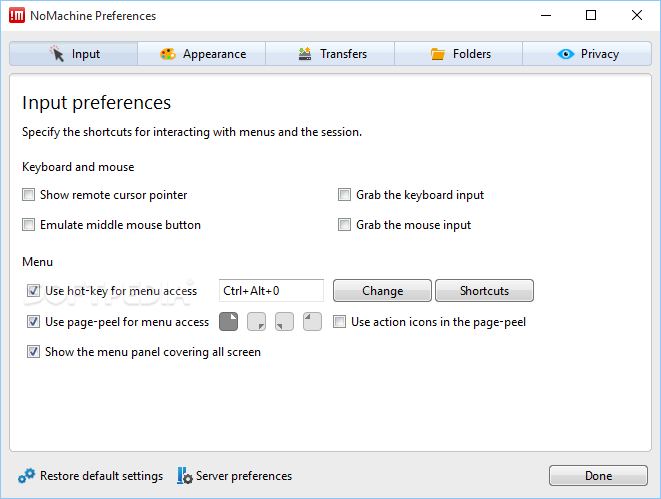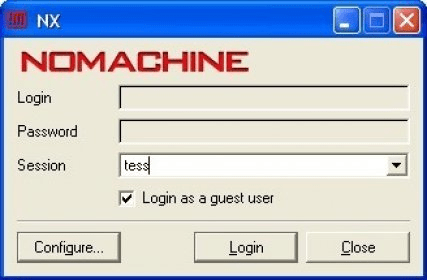

- Nomachine client how to use mac osx#
- Nomachine client how to use install#
- Nomachine client how to use software#
- Nomachine client how to use password#
Now click Create a new desktop or custom session. Please click on the All Desktops at the top of the screen and change to My Desktops. In some instances after logging in you may be presented with many icons for connections to other users desktops. If you want to process and analyse data, copy data home, etc then please use the "Automatically select a node" icon - don't use beamline workstations for this work. If you have beamtime choose the beamline you wish to use (you will only be presented with beamlines you have time on). If you don't have scheduled beamtime you will automatically be connected to a node of the compute cluster. Open this new connection - use this next time you want to access Diamond. Give a name to the new connection, e.g. Nomachine client how to use password#
Use password authentication and don't use a proxy.Set hostname to nx.diamond.ac.uk (ensure port is set to 4000).First time users create a new connection using the Protocol: NX.at home), make sure routers and servers are working normally (usually a after reboot).
Nomachine client how to use install#
Download and install the latest NoMachine client for your operating system from NoMachine. Nomachine client how to use mac osx#
Remote access is available from Linux, Mac OSX and Windows computers. Answer "yes" to the "No Machine is being shutdown at next boot" prompt.New remote access is available at Diamond to login on MX beamlines or NX cluster.
 Click the "Connections" button from "On" to "Off". If you don't want port 4000 open on your mac, be sure to turn on your Firewall and/or disable "Connections" under "Preferences". No Machine will by default open up TCP port 4000 on your mac as it installs the NX Server product as well as the NX Client. Otherwise, you will be connected to a Linux desktop environment on a server in. Unfortunately, if you take too long answering the questions, you may get disconnected (there's a time limit on starting the connection). you may get a few more information windows that pop up. It may ask you to open a port on the firewall so that NoMachine can make connections to itself locally. The second window you see when you connect for the first time is a notice from the operating system. You are connecting to the correct server if the window shows this RSA fingeprint: 78:6f:5e:70:0b:1e:57:27:f2:7b:74:c7:84:f1:3a:19. The first one asks you to verify the SSH RSA key of the host. The first time you connect you will be presented with four dialogs. Select the "Create a new GNOME virtual desktop" (or KDE if you like) and then check the "Save this setting in the connection file" box and press the Continue button:. Type in your HawkID username and passphrase. Click on the "CLAS Linux Desktop" and press the Connect button:. Enter "CLAS Linux Desktop" in the Name field and press the Done button:.
Click the "Connections" button from "On" to "Off". If you don't want port 4000 open on your mac, be sure to turn on your Firewall and/or disable "Connections" under "Preferences". No Machine will by default open up TCP port 4000 on your mac as it installs the NX Server product as well as the NX Client. Otherwise, you will be connected to a Linux desktop environment on a server in. Unfortunately, if you take too long answering the questions, you may get disconnected (there's a time limit on starting the connection). you may get a few more information windows that pop up. It may ask you to open a port on the firewall so that NoMachine can make connections to itself locally. The second window you see when you connect for the first time is a notice from the operating system. You are connecting to the correct server if the window shows this RSA fingeprint: 78:6f:5e:70:0b:1e:57:27:f2:7b:74:c7:84:f1:3a:19. The first one asks you to verify the SSH RSA key of the host. The first time you connect you will be presented with four dialogs. Select the "Create a new GNOME virtual desktop" (or KDE if you like) and then check the "Save this setting in the connection file" box and press the Continue button:. Type in your HawkID username and passphrase. Click on the "CLAS Linux Desktop" and press the Connect button:. Enter "CLAS Linux Desktop" in the Name field and press the Done button:.  Select "Don't use a proxy" and press the Continue button:. Don't select any thing for the "Use an alternate server key" and press the Continue button:. Select the "Use NoMachine login" and press the Continue button:. Change the port TO 40 from 22 and press the Continue button: Change the Protocol from "NX" to "SSH" as shown and press the Continue button:. Click on the "Click here to create a new connection" below:. Check the "Don't show this message again" box and press Continue on the welcome screen below:. Go to Applications (in Finder) and launch the application "NoMachine." Check the "Don't show this message again box" and then click Continue on the welcome screen below:.
Select "Don't use a proxy" and press the Continue button:. Don't select any thing for the "Use an alternate server key" and press the Continue button:. Select the "Use NoMachine login" and press the Continue button:. Change the port TO 40 from 22 and press the Continue button: Change the Protocol from "NX" to "SSH" as shown and press the Continue button:. Click on the "Click here to create a new connection" below:. Check the "Don't show this message again" box and press Continue on the welcome screen below:. Go to Applications (in Finder) and launch the application "NoMachine." Check the "Don't show this message again box" and then click Continue on the welcome screen below:. Nomachine client how to use software#
Click through the NoMachine.pkg install prompts to install the No Machine software on your Mac.After you finish downloading, navigate to your Downloads folder in the Finder and double click on the NoMachine.pkg to start the installation of NoMachine.Download the NoMachine Client Software for MacOS.Tested on OSX 10.9.4 and NX Client 4.2.27. To install the client, you must have permissions to install software on your Mac.







 0 kommentar(er)
0 kommentar(er)
